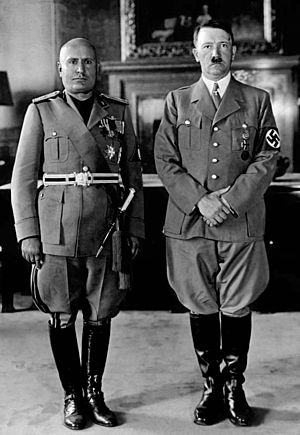Fascism facts for kids
Fascism is a type of government where one ruler holds most of the country's power. Fascist governments are usually totalitarian and authoritarian. This means the government controls almost everything. It is often a one-party state, where only one political party is allowed.
Under fascism, the government strongly controls the economy and other parts of society. It uses violence to arrest, kill, or stop anyone it does not like.
Three major fascist countries were Italy under Benito Mussolini, Nazi Germany under Adolf Hitler, and Spain under Francisco Franco.
Mussolini created fascism in Italy in the late 1910s. He fully developed it in the 1930s. When Hitler came to power in Germany in the 1930s, he copied many of Mussolini's ideas.
Contents
What Fascism Means
People have different ideas about what fascism truly is. One way to understand it is as a system focused on a single powerful leader. This leader promises to make the country great again. They often say the country has been hurt by groups like communists, Marxists, minorities, or immigrants. These groups are supposedly a threat to the nation's history and character.
This means:
- Fascism centers around one strong leader.
- It often says that communism is bad.
- It blames certain groups of people for the country's problems. These groups can be from other countries or within the country itself.
- Fascism promises to fix these problems by getting rid of the groups it sees as bad.
For example, under Hitler's fascist Germany, the government blamed Jewish people, communists, people with disabilities, Roma, and other groups for Germany's problems. They arrested these people. Many were taken to camps and killed in what is known as The Holocaust.
In 2003, Dr. Lawrence Britt listed "14 Defining Characteristics of Fascism":
- Nationalism: Believing one's own country is better than others.
- Disregard for human rights.
- Scapegoating: Blaming others for the country's problems.
- Prioritizing the military.
- Sexism: Believing men are better than women.
- Controlling mass media: The government tells newspapers and news sources what they can report.
- Focusing on national security.
- Close ties between religion and government.
- Protecting businesses and corporations.
- Preventing labor unions from becoming powerful.
- Disliking intellectuals and the arts: Not listening to scientists, scholars, or artists.
- Strong focus on crime and fighting it.
- Corruption within the government.
- Dishonest elections: Even if people vote, the votes might not be counted fairly. Sometimes, leaders even harm their opponents.
Where the Name Comes From
The word "fascism" comes from the Italian word fascio, which means 'bundle'. This word comes from the Latin word fasces. A fasces was an axe surrounded by a bundle of sticks. In Ancient Rome, leaders carried the fasces as a symbol of their power.
How Fascism Started
A journalist named Benito Mussolini created fascism. He started Italy's fascist party in 1919. He became Italy's prime minister in 1922. He was not elected. His supporters marched into Rome in large numbers. The king of Italy then made him prime minister. Even though a "grand council" officially ruled the fascist party in Italy, Mussolini held almost all the power. This lasted from 1922 until the end of World War II.
According to scholar Ruth Ben-Ghiat, Mussolini believed democracy had failed. He had been a socialist but left that movement too. He thought democracy failed because of social class differences. Mussolini said that under fascism, people would focus on the nation. They would not think about social class.
However, Mussolini also believed that to make fascism work, he had to remove anything that could distract people from the nation. He decided who counted as a "real Italian." He would arrest or remove anyone he said did not belong. He believed it was right to use violence to remove these distractions and people. Groups of armed followers would go into the streets. They would beat up or even kill people Mussolini disliked.
Mussolini did not allow journalists to write what they wanted. He believed Italy should be made of white people. So, he encouraged white women to have more babies. He also treated people who were not white unfairly.
Why People Oppose Fascism
People in democratic countries oppose fascism for many reasons. A main reason is that in a fascist government, citizens often cannot vote freely. They also might not be allowed to live a lifestyle that the government sees as "immoral" or "unproductive."
Fascism in the 20th and 21st Centuries
Fascist governments in Italy and Germany ended after they lost World War II. However, fascism continued in other places. This included military dictatorships under Salazar in Portugal and Franco in Spain. It also appeared in some parts of Latin America, Africa, and Asia.
In the 21st century, fascist political movements still exist in many countries around the world.
Related pages
Images for kids
-
Filippo Tommaso Marinetti, author of the Futurist Manifesto (1909) and co-author of the Fascist Manifesto (1919)
-
Benito Mussolini in 1917 as a soldier in World War I. He founded the Fasci d'Azione Rivoluzionaria in 1914.
-
Residents of Fiume cheer Gabriele d'Annunzio and his blackshirt-wearing nationalist raiders.
-
Benito Mussolini with three of the four quadrumvirs during the March on Rome.
-
Nazis in Munich during the Beer Hall Putsch.
-
Benito Mussolini (left) and Adolf Hitler (right).
-
Juan Perón, President of Argentina (1946-1955 and 1973-1974), admired Italian Fascism.
-
Giorgio Almirante, leader of the Italian Social Movement (1969-1987).
-
Hitler and Spanish dictator Francisco Franco in Meeting at Hendaye, on 23 October 1940.
See also
 In Spanish: Fascismo para niños
In Spanish: Fascismo para niños



















